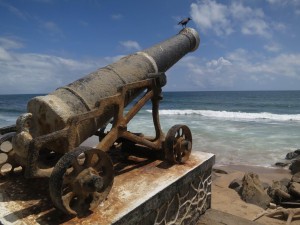Travel Day 1110 – Colombo, SRI LANKA
It was finally my first full day, my Arrival Day, in Sri Lanka, but something didn’t seem quite right…
Actually, a few things didn’t seem quite right, but the first one was that Sri Lanka didn’t feel like India at all. I was obviously aware of the fact that Sri Lanka was a separate island and a separate country, but because of it’s proximity to India and because it used a part of the British Empire, I was expecting at least certain similarities. Also a good potion of the population was considered Tamil, as the people from Tamil Nadu in Southern India and that too made me believe that there should be certain parallels in culture…
But first off, Colombo struck me as much to clean, modern and organized. And even if the people looked like the people from India and even if they had the same kind of rickshaws cruising around, everything was completely hustle free. Sometimes a rickshaw would stop, asking if I needed one and all I had to do was friendly decline to see them taking off again. But what was even stranger was the fact that there were no cows roaming around and that there was no chai wallah to be seen anywhere…
It was all a bit strange and difficult to digest on my Arrival Day, but after all Sri Lanka was a Buddhist country and as I found out later, tea had only arrived from India in the 19th century through the British colonizers. But prior to the British, the Dutch and the Portuguese had arrived in Sri Lanka, or Ceylon as it used to be called and they all left their very own colonial flavor behind. Finding some of those colonial traces became thus my main objective during my stay in Colombo…
I obviously had to start with the Portuguese, who had arrived as the first European colonizers in Sri Lanka in 1505 in order to start a lucrative spice trade. Much as in many coastal places in India, along with the arrival of the Portuguese came a lot of construction of colonial houses, churches and forts to secure the harbors as well as the surrounding area. One of these early Portuguese settlements was Colombo, which had been initially granted as a trading post, but by 1517 the Portuguese had established an actual fort. Liking all sorts of fortresses, I obviously couldn’t resist making the historic center of Colombo, the island called Fort, my destination of my first exploration walk through Colombo…
So I walked from the area where I stayed all the way along Galle road to the historic Portuguese center of Fort Colombo to see what was left from the colonial fort. But unfortunately as I was asking once “Where is the Fort in Fort Cochin?” I was once more faced with the reality that there was no fort in Fort Colombo and especially no Portuguese fort. As I found out in a small maritime museum, the Portuguese fort had obviously once existed, but it was demolished and replaced by a Dutch fort, which was in turn demolished by the British…
The only reminder I could find of a colonial fort were some old rusty canons that were put by the shore, but besides that, Colombo appeared as a pretty modern city with glass skyscrapers and all sorts of modern facilities. In fact there appeared to be no Portuguese colonial traces at all in the city center and so I ended my sweaty day of walking the extremely hot streets of Colombo by watching the sunset at Galle Face Green. Every single person with their cat and dog seemed to come here at the end of the day to enjoy the views, the water and some food at the open promenade. At the end of the day I hadn’t found the Portuguese fort, but at least on my Arrival Day I had found the best place in town to watch the day turn into night and have a chat with some friendly locals of Sri Lanka…
Find all Colombo Photos here.



Leave a Reply